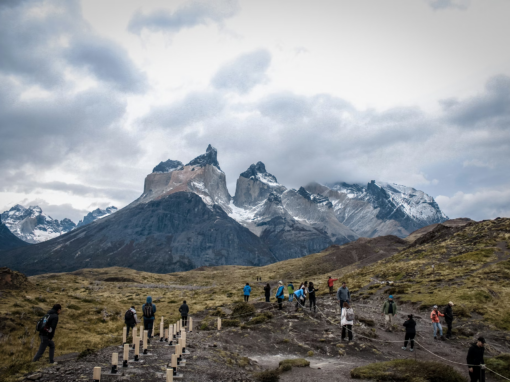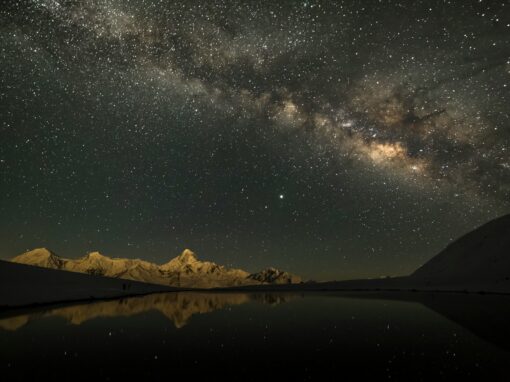By Nicole Reis for ContactChile
San Pedro de Atacama is an oasis located in the northern part of Chile at 2.408m above sea level and is surrounded by volcanoes, most of which reach above 5.000m. They form the natural border to Bolivia and Argentina.
The town can be easily reached by car in an hour’s drive from Calama airport, a paved road which leads through the desert. The city centre is very touristy but has managed to look quite authentic, mainly due to the way the houses are constructed, with lots of brown natural stone and wood. It is the logistic center of the region, where you can and must stock up on gasoline, water and food before a trip to the surrounding sights, as there is no more gas station until the Argentine border. A traffic sign on the Ruta 27 informs: “no mobile phone network until the pass”.
I have rented a campervan and will be exploring the desert of San Pedro de Atacama together with a friend. Having the bedroom on wheels offers the possibility to discover the sights around San Pedro in the absence of most tourists. This is rather nice as at certain times, they arrive numerously by car and flood the affectionately arranged paths and observation platforms chattering and posing for selfies, some more respectful than others.

El Tatio
Anyone who has visited geysers in the U.S. or in Russia before will not be taken aback by El Tatio, but who can claim to have strolled over a volcanic field at 4,300 m above sea level? Spending the night in the parking lot of the park guards is not a good idea though, as the temperature drops to several degrees below zero even in summer. However, this little adventure allowed us to enjoy the natural hot springs of the largest geyser field in the southern hemisphere two times, once at night and a second time in the morning. The best time to visit the bubbling, steaming and gurgling holes is in the early morning. The air is clear and cold. You will dive in and out of clouds of vapour, which smells slightly of sulphur. At this time of day, the eruptions, are the biggest, because the cold night air provides the necessary pressure difference. Geysers range in size from cracks and small holes in the earth to a small hill. Impressive is also a big hole with crystal clear water, which looks temptingly like a hot tub, but be careful: the water is boiling hot, at around 86°C. You can walk around quite freely with red painted stones limiting the way (no guide needed). Slowly there are more and more tourists gathering around us and our fingertips are ice-cold, so we decide to make our way down to the natural pool and warm up in the volcanic water.
Valle Arcoiris
Back in San Pedro we refuel and set off for the “Rainbow” valley, which can be reached by car in about 1.5 hours. The rocks in this canyon shine in countless colours, red, white, yellow, even green. The furrowed rocks glitter magically in the afternoon sun thanks to crystals enclosed in the fissured rock. On the way back you can admire the petroglyphs of Yerba Buena.

San Pedro Atacama – Photo: Nicole Reis 
San Pedro Atacama – Photo: Nicole Reis
We spend the night south of San Pedro, in the middle of the desert. Adventurers will love wild camping in San Pedro, because there is not only absolute silence at night but also the most beautiful sky in Chile above you. There are countless private observatories around San Pedro, most of them also offer tours. These are worthwhile taking, as a view through the telescopes brings you even closer to Jupiter, Venus or Orion – absolutely breath-taking!
Laguna Miscanti / Laguna Miñiques
Today we want to visit the lagoons Miscanti and Miñiques. These are located in the mountain plateau Altiplano, at over 4,000 m above sea level. A dirt road leads from the national road 23 steeply up to the lagoons. Even this ascent manages our camper without any major problems, and we admire the deep blue of the lagoons during a walk. Although you can see flamingos on all advertising pictures, there are only a few of these long-legged animals to be seen here – which makes sense, as the deeper the lagoon, the fewer flamingos there are.
We follow the national road 23 further towards the Argentine border up to Paso Sico. A wonderful drive. The road leads us steadily ascending to two salt lakes, the Salar Aguas Calientes. The afternoon sun lets the tufts of grass shine in a golden yellow an occasionally we meet a group of vicuñas. They either stop and observe us while continuing chewing the dry grass or they flee from us.
Our camper rattles along the mostly perfectly paved road until we reach a collection of buildings that look like a mixture of research station and farm. A man steps out the door at this very moment and we use the convenient coincidence to ask him about the condition of the road ahead of us. We chat a little and he then sends us to ask at the police station about 7km further towards the Argentinian boarder. We ask the officer on duty, to whom the two tourists probably offer a welcome change/entertainment, if we can take the road through the mountains back to San Pedro with our vehiculo. His laughter is priceless and for us it is clear: we will visit the vicuñas again.
We spend the night in Peine, a small village of miners and their families, high above the salt desert. It is very windy; clouds of sand are buzzing around our camper. Cooking on the small gas cooker is our next little challenge – it is therefore quite handy that our bed can easily be converted into a table inside the campervan. About every 10min a curious worker peers in at the window of your camper. He is either on his way to the bus that takes him to the mine or back from work (buses regularly arrive from somewhere on the parking lot where we parked our camper and bring sweaty, dirty workers with tired faces. Soon they are driving into the unknown again, full of fresh workers). Today the sun sets in a haze of sand. Above us, thousands of stars glitter in the dark night sky.

Salar de Atacama
In the morning the salt desert of Atacama spreads out below us in its full size. The Salar de Atacama, a flat, gigantic, white nothing, the extent of which can only really impress from up here. There are two touristic stops that should not be missed: one is the Laguna Chaxa, the other the Laguna Cejar. After arriving at the Laguna Chaxa a strict, indigenous park guard warns us form the strong sun radiation and leads us to the very informative little museum. After paying the entrance fee one can head out to the hot white salt flat. Finally – there they are: flamingos! They pose in the smooth lagoon that reflect the light like a mirror. The sun burns hot from the sky while we follow the path leading towards the lagoon. There is an inviting, shady veranda with stone tables, perfect for lunch or a few snacks.

Laguna Cejar – Photo: Nicole Reis 
Laguna Chaxa – Photo: Nicole Reis
During our visit, only two flamingos gathered at Laguna Cejar, however, the Laguna Piedra where you can swim, is very impressive. Floating would be the most appropriate term, as in this surprisingly deep lagoon one floats effortlessly on the water surface due to the enormous salt content. We visit both lagoons in the morning, as tour buses usually stop here on their way back from Laguna Miscanti and Miñiques. Be careful, you are in the middle of the salt desert, with no natural shade and you are not allowed to use sunscreen in Laguna Piedra. There are fresh water showers and clean toilets and changing cabins.
San Pedro de Atacama
Back in San Pedro we gas up and head for the market for some fresh fruit and veg. However tonight we spoil ourselves with a proper meal in a restaurant (a dish without sand), as we booked an observatory tour for the night which picks us up in San Pedro. The prices are fairly high on touristy streets like Caracoles and around the main square, Plaza de San Pedro. It is advisable to bring enough cash. In front of the two ATMs people are regularly queuing. Most tours can be paid by credit card and the touristy restaurants also accept them. However, if you are exploring the area on your own, it is necessary to carry enough cash.
You can also find local food in San Pedro, of course. Around the soccer field, which the Ataceños proudly call a stadium, are small restaurants that offer a dozen tables and a small menu. Lomo a lo pobre, a hamburger the size of the dish or a small mountain of Espaghetti are freshly prepared. After eating one of those dishes you are certainly not hungry anymore and they are not beyond the budget of a backpacker either.
Pukara de Quitor
The ruins of the Pukará de Quitor, located only 2 km north of San Pedro, tell the story of the first settlers and brave Atacameños who, after the conquest by the Incas, defied the first gold seekers and later the Spanish. The walls of the fortress, which hide a labyrinth of corridors and rooms, which in its days have sheltered not only people but also animals and the legendary gold of the Andes. Today, it needs quite some fantasy to imagine the hustle and bustle of the fortress, which can no longer be entered. The view over San Pedro and the vast salt desert, all the way to the Valley of the Moon, as well as the wonderfully cool breeze, make up for the short but hot climb to the Mirador mountain next to the ruins.
Valle de la Luna
The Valley of the Moon is a gigantic valley with countless rock formations that, in my opinion, have little in common with the moon, but certainly belong to the obligatory stops. At the visitor’s center, we got useful information and a map. From there, we approached the valley along the rough natural path, passing by diversified rock formations whose colour range from various shades of yellow to white. At the time of the sunset, the rocks “become” red and brown. There are some huge sand dunes which I found most impressive. They can be admired from a long rocky hill. If you come here at dusk, you can admire the sunset and the golden light playing on the rocks.
San Pedro de Atacama and its surroundings can be explored either as an individual traveller or with guided tours. But come prepared, gloves, a coat and good shoes are a must, as well as sunglasses and sunscreen. The north of Chile will surprise you with its indescribably varied and contrasting nature and an impressive night sky.
¿Have you visited San Pedro de Atacama? ¿Would you like to go? Tell us in the comments section!



